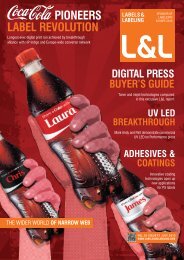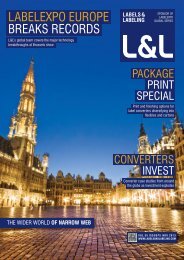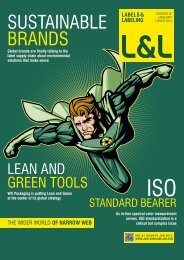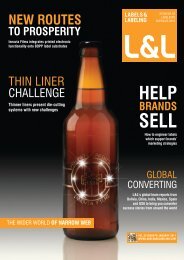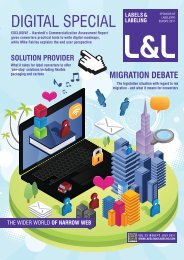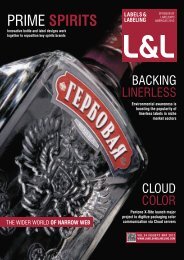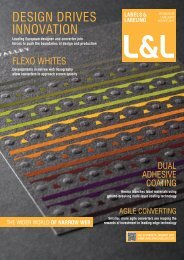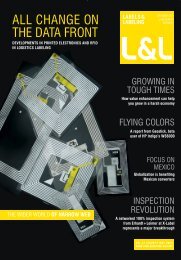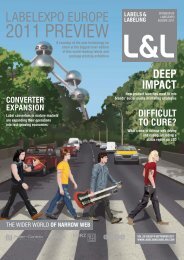You also want an ePaper? Increase the reach of your titles
YUMPU automatically turns print PDFs into web optimized ePapers that Google loves.
44 | L&L<br />
(L-R) Roger Pellow, MD, labels and packaging group, Tarsus,<br />
Mitsuo Komiyama, MSP, and Akio Nemoto, general manager, Lintec<br />
Addressing Asia<br />
LABEL CONVERTERS are looking to expand operations overseas and seek new markets in Asia, as Roger<br />
Pellow discovered meeting MSP owner Mitsuo Komiyama<br />
Mitsuo Komiyama and his wife set<br />
up label converter MSP in Japan<br />
over 30 years ago. It was a partner<br />
of local printing press and materials<br />
manufacturer Lintec for most of this<br />
time, which was a great support for the<br />
company in the early days.<br />
MSP started out printing plain labels<br />
and now specializes in the industrial and<br />
consumer electronics markets, which<br />
account for 70 percent of the company’s<br />
label printing business, as well as<br />
track and trace label systems. Half of<br />
the company’s turnover comes from a<br />
specialist die-cutting operation, which<br />
uses custom made machinery, Koto solid<br />
dies and Tsukatni flexible dies.<br />
BUSINESS CHALLENGES<br />
In addition to three plants in Japan<br />
– the oldest is located in Uenohara<br />
and has been there since 1998 – MSP<br />
moved into the Philippines in 2008 and<br />
expanded into Thailand in 2009. It has<br />
115 employees globally, with 80 of these<br />
based in Japan.<br />
Komiyama explains, ‘Margins in Japan<br />
are very tight due to the high cost of<br />
the labor and deflationary economics,<br />
LABELS&LABELING<br />
which has made it difficult to put through<br />
price increases in the last 10 years. We<br />
expanded into the Philippines because<br />
labor cost there is one tenth of the cost<br />
in Japan, as well as allowing us to open<br />
new markets.’<br />
Komiyama’s son, Satoshi, is also<br />
involved in the business as head of sales.<br />
He believes the biggest challenge is the<br />
Japanese economy – the Great East<br />
Japan Earthquake caused the Japanese<br />
label market to decrease by one to two<br />
percent in early 2011 but it is expected to<br />
recover by two percent in 2012. Despite<br />
this, the company has continued to<br />
grow at seven percent per annum and<br />
reports an annual turnover of three billion<br />
Japanese yen, in comparison to the<br />
average Japanese label printer’s turnover<br />
of one billion yen.<br />
According to Komiyama, the overall<br />
market in Japan is flat and some label<br />
printers are going out of business.<br />
Large companies are getting bigger and<br />
acquiring others whilst small businesses<br />
are surviving in niche markets. ‘It is<br />
the middle companies that are being<br />
squeezed out.’<br />
As key customers, such as Toshiba,<br />
move out of Japan, MSP is focusing<br />
on addressing overseas markets and<br />
exports 20 percent of business into<br />
Asia-Pacific. Komiyama adds that in<br />
Thailand the company produces high<br />
volume, low margin work like price-weigh<br />
labels.<br />
In line with the electronic companies it<br />
serves, MSP has a strict ‘no shoe’ policy<br />
within its plants. Another unusual quirk<br />
is the inspection method. After normal<br />
inspection, a final check is carried out<br />
manually in a special climate controlled<br />
inspection room.<br />
Most materials are supplied by Lintec<br />
and an inventory of just one week is kept.<br />
MSP has been paying to recycle all its<br />
waste for the past five years, sending<br />
matrix waste to a recycling company<br />
where it is turned into fuel pellets.<br />
MSP moved into digital printing with<br />
an HP Indigo ws4500 two years ago.<br />
However, Komiyama says: ‘We are still<br />
learning how to make good money out of<br />
it’. The average digital print run is 5,000<br />
labels compared to an average print run<br />
of 30,000 labels on the company’s Lintec<br />
and Sanjo letterpress machines and<br />
Mark Andy 22000 10-inch flexo press.



